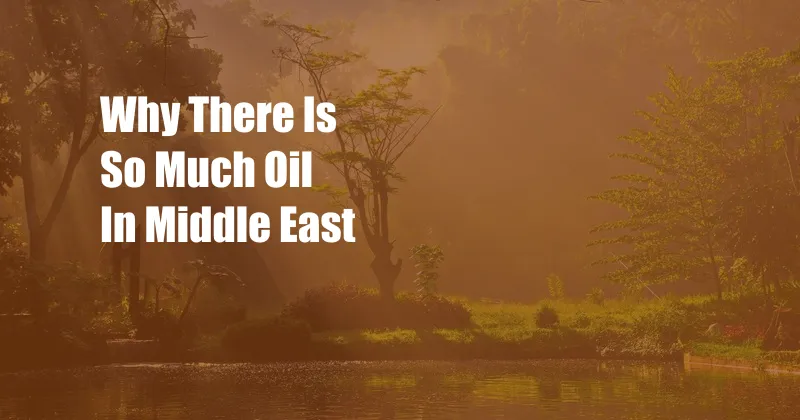
Why the Middle East Is Awash in Oil: A Journey Through History
From the bustling souks of Dubai to the ancient ruins of Petra, the Middle East has long been a land shrouded in mystery and intrigue. Its deserts hold some of the world’s most valuable resources, including the vast reserves of oil that have shaped its history and destiny. But what lies beneath the sands of this enigmatic region, and why is it so rich in this precious commodity?
Our journey begins millions of years ago, when the Arabian Peninsula was submerged under a vast sea. Over time, the shifting continents and ocean currents deposited layers of marine sediments on the seabed. These layers contained microscopic algae and other organic matter that would later transform into oil and gas.
Tectonic Shifts and the Formation of Oil Traps
As the Earth’s tectonic plates collided and shifted, the Arabian Peninsula emerged from the ocean. The uplift of the landmass created huge folds and faults in the underlying rock formations. These geological structures formed natural traps that accumulated the oil and gas that had been formed over time.
The presence of these traps was crucial for the preservation of oil in the Middle East. Without them, the oil would have dispersed into the surrounding rock formations and evaporated over time. Instead, it became trapped beneath impermeable layers of rock, safely protected for millions of years.
Ancient Seabeds and the Abundance of Marine Life
The rich biodiversity of the ancient sea that covered the Middle East played a significant role in the formation of its oil reserves. The abundance of marine life, particularly microscopic algae and plankton, provided the organic raw material that would later turn into hydrocarbons.
As these organisms died and sank to the bottom of the sea, they became buried under layers of sediment. The heat and pressure of the overlying layers transformed the organic matter into oil and gas. The unique combination of ancient seabeds, tectonic shifts, and abundant marine life created a perfect storm for the formation of vast oil reserves in the Middle East.
The Rise of Oil Production and Its Global Impact
The discovery and exploitation of oil in the Middle East transformed the region and the world. In the early 20th century, oil exploration companies began to drill for oil in the Arabian Peninsula, and soon the Middle East became the world’s leading source of crude oil.
The newfound wealth from oil production had a profound impact on Middle Eastern societies. It fueled rapid economic development, improved infrastructure, and raised living standards. However, it also brought with it political and social challenges, as countries grappled with the sudden influx of wealth and power.
Exploring New Frontiers: Unlocking the Potential of Offshore Fields
As demand for oil continued to grow, exploration moved beyond the traditional onshore fields. In the 1960s and 1970s, oil companies ventured into the waters of the Arabian Gulf and the Red Sea, discovering vast offshore oil fields that further boosted the region’s oil reserves.
The exploitation of offshore fields presented new challenges, requiring advanced drilling technology and specialized platforms. However, the technological advancements made in offshore exploration have played a significant role in unlocking the Middle East’s full oil-producing potential.
Tips for Understanding the Middle East’s Oil Industry
- Learn about the history of oil exploration in the region: Explore the events and milestones that shaped the Middle East’s oil industry.
- Study the geology of the region: Understand the geological formations that led to the accumulation of oil in the Middle East.
- Follow industry news and updates: Stay informed about the latest developments in oil production, exploration, and global oil markets.
- Seek expert insights: Consult with geologists, engineers, and industry analysts to gain a deeper understanding of the topic.
By following these tips, you can gain a comprehensive understanding of the factors that have contributed to the Middle East’s abundance of oil. It is a complex and fascinating topic that continues to shape the region and the world today.
FAQs on Oil in the Middle East
Why is the Middle East so rich in oil?
The Middle East’s oil reserves are the result of a unique combination of ancient seabeds, tectonic shifts, and abundant marine life, which created natural traps that accumulated and preserved oil over millions of years.
How has oil production impacted the Middle East?
Oil production has transformed the Middle East, leading to rapid economic development, improved infrastructure, and increased living standards. However, it has also brought political and social challenges.
What are the challenges of offshore oil exploration in the Middle East?
Offshore oil exploration presents challenges such as deep waters, strong currents, and complex geological formations. However, advanced drilling technology and specialized platforms have been developed to overcome these challenges.
Conclusion: The Strategic Significance of Middle Eastern Oil
The Middle East’s vast oil reserves have played a pivotal role in its history and continue to shape its present and future. The region’s oil wealth has brought both economic prosperity and political challenges. Understanding the factors that have made the Middle East so rich in oil is crucial for comprehending its complex dynamics and its significance in the global energy landscape.
If you found this exploration of the Middle East’s oil history and reserves informative, please share your thoughts and engage further with this fascinating topic. Your contributions can help expand our collective understanding of this essential aspect of our world’s energy supply.